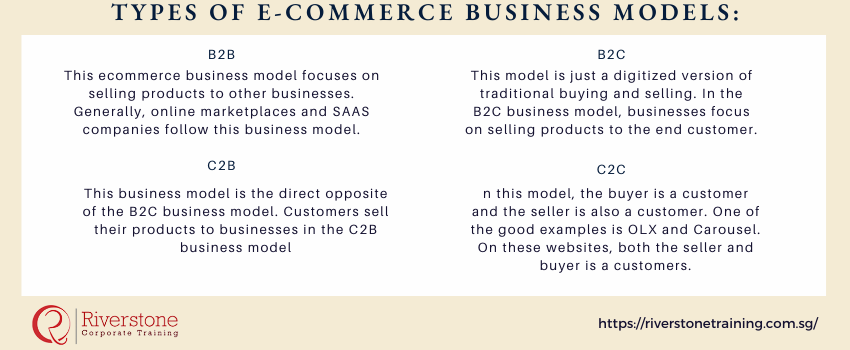
WHAT IS E-COMMERCE BUSINESS MODEL?
The term e-commerce is very familiar to the ears. Isn’t it? It is commerce merged with the internet. E-commerce business model describes the process of buying and selling over the internet. In this model, businesses tend to sell their products on the internet through their brand website or another online shopping website.
E-commerce business model is just a technical term for the daily online shopping we do. The rise of technology has changed the whole process of buying and selling. There are so many businesses that have entered into the e-commerce business model by building their website. The small retail stores who don’t have their website, sell their products on other big online shopping sites. One of them being Amazon.
Classification of E-commerce Business Model:
Some essential e-commerce business model classification is drop shipping, wholesaling and warehousing, white-labeling and manufacturing.
The drop shipping is a retail model where the business doesn’t need a budget for fulfillment costs. It can partner with a wholesaler who will stock the inventories of the company and directly deliver it to the customers. The business needs a website displaying all the products on the internet.
The wholesaling and warehousing business model is appropriate for businesses with huge investments. In this model, the companies directly buy products from the manufacturer or the middleman. They store these products in a warehouse and sell them at a profitable rate.
Whereas, white-labeling and manufacturing are appropriate for a business with almost no investment for production. Companies, in this model, outsource the production and sell the products with their brand name.
Understanding these models is crucial for effective business segment analysis for investors, helping them assess potential profitability and risk across different operational approaches in the e-commerce sector.
TYPES OF E-COMMERCE BUSINESS MODELS:
There are types of e-commerce business models to serve different are categories of customers.
B2B Ecommerce Business Model:
This ecommerce business model focuses on selling products to other businesses. Generally, online marketplaces and SAAS companies follow this business model.
B2C E-commerce Business Model:
This model is just a digitized version of traditional buying and selling. In the B2C business model, businesses focus on selling products to the end customer. Retail e-commerce stores, social shopping websites like Amazon, Flipkart work in this business model.
C2B E-commerce Business Model:
This business model is the direct opposite of the B2C business model. Customers sell their products to businesses in the C2B business model. Some of the good examples are websites taking freelancing services like Upwork.
C2C E-commerce Business Model:
In this model, the buyer is a customer and the seller is also a customer. One of the good examples is OLX and Carousel. On these websites, both the seller and buyer is a customers. Also, it helps you get rid of your old or not in use stuff and someone else gets to benefit from your sold products.
Technology has shaped a lot of things, and e-commerce is one of them. This business model helps businesses expand. Businesses can build their market and reach out to customers all over the world.
Choosing the Right E-commerce Business Model for Your Singaporean Startup: A Practical Guide
Want to know how to start business online in Singapore? The key thing is to make the right choice of an e-commerce model! Or rather, should you dropship without inventory or to sell B2C (to consumers)? Maybe your product suits a B2B sell model of selling to companies. This handbook will lead potential entrepreneurs in Singapore through the advantages and the disadvantages of different models taking into account local market peculiarities and resources availability. Below, you will find out how to evaluate your product, target audience, and operational possibilities and decide on the e-commerce blueprint with the confidence that your Singapore startup has the chances of success. Choosing the right e-commerce model is just the start—understanding your business’s value is what drives smart growth. Courses like How to Master Business Valuation Certification Course Singapore: A Comprehensive Course can equip Singaporean founders with the insight needed to scale with confidence.
Navigating Singapore’s E-commerce Landscape: Key Platforms, Logistics, and Legal Considerations
Entering e-commerce in Singapore can never be about a product and you should know what is going on in the ground! This material will offer a hands-on opinion on the most successful online retail platforms that are popular among Singaporean clients, such as Shopee, Lazada, and Amazon.sg. We also will get into the must-have logistic solutions, including the local courier services and effective warehousing which is vital in ensuring that the island to island delivery goes smoothly. Additionally, we will address some important legal aspects, including consumer protection laws and data privacy laws so that your online business develops legally, and safely in Singapore. For businesses planning strategic entry or acquisitions in Singapore’s digital market, understanding legal due diligence in Singapore acquisitions is essential to ensure regulatory compliance and risk mitigation.
Emerging E-commerce Business Models and Trends in Singapore
The world of e-commerce is constantly changing, and Singapore is at the forefront of these exciting new trends! On the one hand, we are already accustomed to B2C and dropshipping models. On the other hand, consider the emergence of social commerce, where buying and selling now occur directly through platforms like TikTok and Instagram. Direct-to-Consumer (D2C) brands that bypass traditional retail channels are also gaining momentum. Here, learn how such emerging techniques are redefining the online marketplace and what it has in store concerning online businesses in future. As these e-commerce trends reshape consumer interactions, applying brand valuation methods for e-commerce is becoming increasingly essential—helping forward-thinking digital entrepreneurs in Singapore measure, optimize, and strengthen their brand’s market value with precision.


